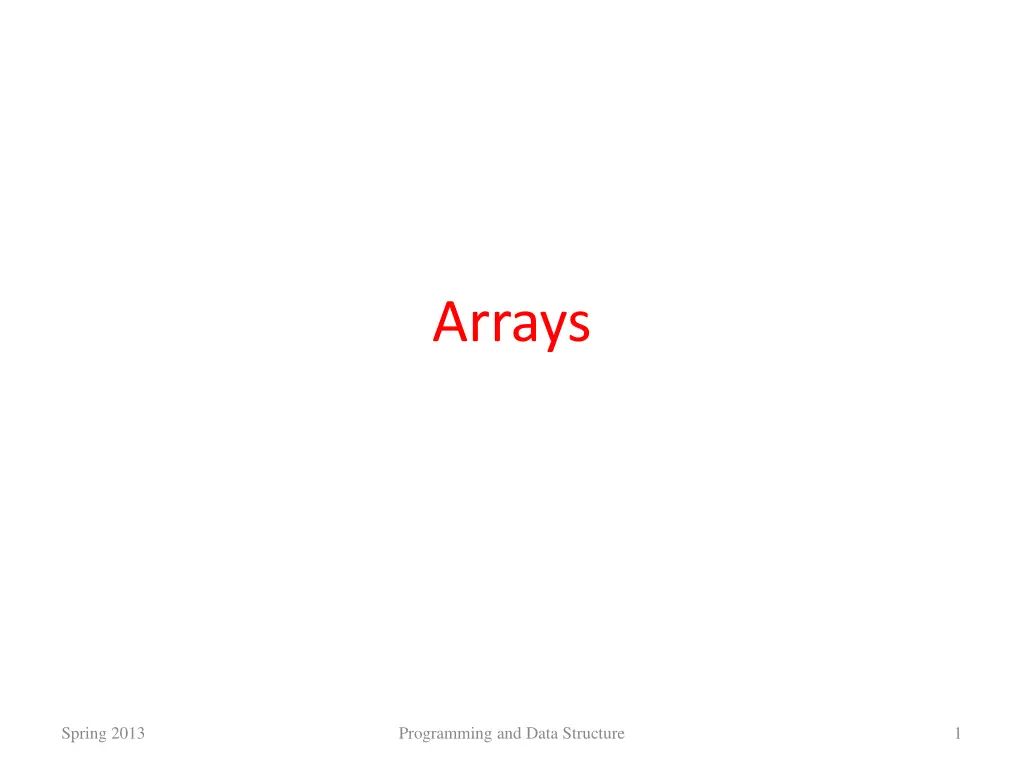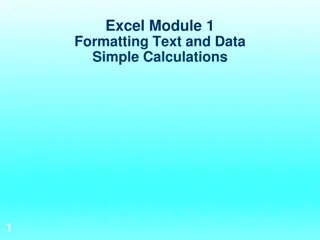
Understanding Arrays in Programming and Data Structures
Explore the fundamental concept of arrays in programming and data structures, their applications, declaration, and memory storage. Learn how arrays are essential for handling multiple data items efficiently and discover how to tackle problems using arrays effectively.
Download Presentation

Please find below an Image/Link to download the presentation.
The content on the website is provided AS IS for your information and personal use only. It may not be sold, licensed, or shared on other websites without obtaining consent from the author. If you encounter any issues during the download, it is possible that the publisher has removed the file from their server.
You are allowed to download the files provided on this website for personal or commercial use, subject to the condition that they are used lawfully. All files are the property of their respective owners.
The content on the website is provided AS IS for your information and personal use only. It may not be sold, licensed, or shared on other websites without obtaining consent from the author.
E N D
Presentation Transcript
Arrays Spring 2013 Programming and Data Structure 1
Basic Concept Many applications require multiple data items that have common characteristics. In mathematics, we often express such groups of data items in indexed form: x1, x2, x3, , xn Why are arrays essential for some applications? Take an example. Finding the minimum of a set of numbers. Spring 2013 Programming and Data Structure 2
4 numbers 3 numbers if ((a <= b) && (a <= c)) min = a; else if (b <= c) min = b; else min = c; if ((a <= b) && (a <= c) && (a <= d)) min = a; else if ((b <= c) && (b <= d)) min = b; else if (c <= d) min = c; else min = d; Spring 2013 Programming and Data Structure 3
The Problem Suppose we have 10 numbers to handle. Or 20. Or 100. How to tackle this problem? Solution: Use arrays. Spring 2013 Programming and Data Structure 4
Using Arrays All the data items constituting the group share the same name. int x[10]; Individual elements are accessed by specifying the index. x[0] x[1] x[2] x[9] X is a 10-element one dimensional array Spring 2013 Programming and Data Structure 5
Declaring Arrays Like variables, the arrays that are used in a program must be declared before they are used. General syntax: type array-name [size]; type specifies the type of element that will be contained in the array (int, float, char, etc.) size is an integer constant which indicates the maximum number of elements that can be stored inside the array. int marks[5]; marks is an array containing a maximum of 5 integers. Spring 2013 Programming and Data Structure 6
Examples: int x[10]; char line[80]; float points[150]; char name[35]; If we are not sure of the exact size of the array, we can define an array of a large size. int marks[50]; though in a particular run we may only be using, say, 10 elements. Spring 2013 Programming and Data Structure 7
How an array is stored in memory? Starting from a given memory location, the successive array elements are allocated space in consecutive memory locations. Array a x x+k x+2k Let x: starting address of the array in memory k: number of bytes allocated per array element Element a[i] :: allocated memory location at address x + i*k First array index assumed to start at zero. Spring 2013 Programming and Data Structure 8
Accessing Array Elements A particular element of the array can be accessed by specifying two things: Name of the array. Index (relative position) of the element in the array. In C, the index of an array starts from zero. Example: An array is defined as int x[10]; The first element of the array x can be accessed as x[0], fourth element as x[3], tenth element as x[9], etc. Spring 2013 Programming and Data Structure 9
Contd. The array index must evaluate to an integer between 0 and n-1 where n is the number of elements in the array. a[x+2] = 25; b[3*x-y] = a[10-x] + 5; Spring 2013 Programming and Data Structure 10
A Warning In C, while accessing array elements, array bounds are not checked. Example: int marks[5]; : : marks[8] = 75; The above assignment would not necessarily cause an error. Rather, it may result in unpredictable program results. Spring 2013 Programming and Data Structure 11
Initialization of Arrays General form: type array_name[size] = { list of values }; Examples: int marks[5] = {72, 83, 65, 80, 76}; char name[4] = { A , m , i , t }; Some special cases: If the number of values in the list is less than the number of elements, the remaining elements are automatically set to zero. float total[5] = {24.2, -12.5, 35.1}; total[0]=24.2, total[1]=-12.5, total[2]=35.1, total[3]=0, total[4]=0 Spring 2013 Programming and Data Structure 12
Contd. The size may be omitted. In such cases the compiler automatically allocates enough space for all initialized elements. int flag[] = {1, 1, 1, 0}; char name[] = { A , m , i , t }; Spring 2013 Programming and Data Structure 13
Example 1: Find the minimum of a set of 10 numbers #include <stdio.h> main() { int a[10], i, min; printf( Give 10 values \n ); for (i=0; i<10; i++) scanf ( %d , &a[i]); Array declaration Reading Array Element min = 99999; for (i=0; i<10; i++) { if (a[i] < min) min = a[i]; } printf ( \n Minimum is %d , min); } Accessing Array Element Spring 2013 Programming and Data Structure 14
Alternate Version 1 #include <stdio.h> #define size 10 main() { int a[size], i, min; printf( Give 10 values \n ); for (i=0; i<size; i++) scanf ( %d , &a[i]); Change only one line to change the problem size min = 99999; for (i=0; i<size; i++) { if (a[i] < min) min = a[i]; } printf ( \n Minimum is %d , min); } Spring 2013 Programming and Data Structure 15
#include <stdio.h> Alternate Version 2 main() { int a[100], i, min, n; printf( Give number of elements (n) \n ); scanf ( %d , &n); /* Number of elements */ printf( Input all n integers \n ); for (i=0; i<n; i++) scanf ( %d , &a[i]); Define an array of large size and use only the required number of elements min = 99999; for (i=0; i<n; i++) { if (a[i] < min) min = a[i]; } printf ( \n Minimum is %d , min); } Spring 2013 Programming and Data Structure 16
Example 2: Computing gpa #include <stdio.h> #define nsub 6 main() { int grade_pt[nsub], cred[nsub], i, gp_sum=0, cred_sum=0, gpa; printf( Input gr. points and credits for six subjects \n ); for (i=0; i<nsub; i++) scanf ( %d %d , &grade_pt[i], &cred[i]); Handling two arrays at the same time for (i=0; i<nsub; i++) { gp_sum += grade_pt[i] * cred[i]; cred_sum += cred[i]; } gpa = gp_sum / cred_sum; printf ( \n Grade point average: is %d , gpa); } Spring 2013 Programming and Data Structure 17
Things you cannot do You cannot use = to assign one array variable to another a = b; /* a and b are arrays */ use == to directly compare array variables if (a = = b) .. directly scanf or printf arrays printf ( , a); Spring 2013 Programming and Data Structure 18
How to copy the elements of one array to another? By copying individual elements int a[25],b[25]; for (j=0; j<25; j++) a[j] = b[j]; Spring 2013 Programming and Data Structure 19
How to read the elements of an array? By reading them one element at a time int a[25]; for (j=0; j<25; j++) scanf ( %f , &a[j]); The ampersand (&) is necessary. The elements can be entered all in one line or in different lines. Spring 2013 Programming and Data Structure 20
How to print the elements of an array? By printing them one element at a time. for (j=0; j<25; j++) printf ( \n %f , a[j]); The elements are printed one per line. printf ( \n ); for (j=0; j<25; j++) printf ( %f , a[j]); The elements are printed all in one line (starting with a new line). Spring 2013 Programming and Data Structure 21
Example: Matrix Addition #include <stdio.h> for (p=0; p<m; p++) for (q=0; q<n; q++) c[p]q] = a[p][q] + b[p][q]; main() { int a[100][100], b[100][100], c[100][100], p, q, m, n; for (p=0; p<m; p++) { printf ( \n ); for (q=0; q<n; q++) printf ( %f , a[p][q]); } } scanf ( %d %d , &m, &n); for (p=0; p<m; p++) for (q=0; q<n; q++) scanf ( %d , &a[p][q]); for (p=0; p<m; p++) for (q=0; q<n; q++) scanf ( %d , &b[p][q]); Spring 2013 Programming and Data Structure 22
Passing Arrays to a Function An array name can be used as an argument to a function. Permits the entire array to be passed to the function. Array name is passed as the parameter, which is effectively the address of the first element. Rules: The array name must appear by itself as argument, without brackets or subscripts. The corresponding formal argument is written in the same manner. Declared by writing the array name with a pair of empty brackets. Dimension or required number of elements to be passed as a separate parameter. Spring 2013 Programming and Data Structure 23
Example: Average of numbers #include <stdio.h> Array as parameter float avg (float x[], int n) { float sum=0; int i; float avg(float [], int ); prototype Number of Elements used main() { float a[]={4.0, 5.0, 6.0, 7.0}; for(i=0; i<n; i++) sum+=x[i]; return(sum/(float) n); } printf("%f \n", avg(a,4) ); } Array name passed 5.5000 Spring 2013 Programming and Data Structure 24
The Actual Mechanism When an array is passed to a function, the values of the array elements are not passed to the function. The array name is interpreted as the address of the first array element. The formal argument therefore becomes a pointer to the first array element. When an array element is accessed inside the function, the address is calculated using the formula stated before. Changes made inside the function are thus also reflected in the calling program. Spring 2013 Programming and Data Structure 26
Contd. Passing parameters in this way is called call-by-reference. Normally parameters are passed in C using call-by-value. Basically what it means? If a function changes the values of array elements, then these changes will be made to the original array that is passed to the function. This does not apply when an individual element is passed on as argument. Spring 2013 Programming and Data Structure 27
Example: Minimum of a set of numbers #include <stdio.h> int minimum (x, size) int x[], size; { int i, min = 99999; main() { int a[100], i, n; for (i=0; i<size; i++) if (min < a[i]) min = a[i]; return (min); } scanf ( %d , &n); for (i=0; i<n; i++) scanf ( %d , &a[i]); printf ( \n Minimum is %d , minimum (a, n)); } Spring 2013 Programming and Data Structure 28
Some Exercise Problems to Try Out Find the mean and standard deviation of a set of n numbers. A shop stores n different types of items. Given the number of items of each type sold during a given month, and the corresponding unit prices, compute the total monthly sales. Spring 2013 Programming and Data Structure 29
Character Strings 28 May 2025 Programming and Data Structure 30
Introduction A string is an array of characters. Individual characters are stored in memory in ASCII code. A string is represented as a sequence of characters terminated by the null ( \0 ) character. H e l l o \0 Hello 28 May 2025 Programming and Data Structure 31
Character vs. String A string constant is a sequence of characters enclosed in double quotes. For example, the character string: char s1[2]="a"; //Takes two bytes of storage. s1: a \0 On the other hand, the character, in single quotes: char s2= `a`; //Takes only one byte of storage. s2: a
Declaring String Variables A string is declared like any other array: char string-name [size]; size determines the number of characters in string_name. When a character string is assigned to a character array, e.g. s= abc ; It automatically appends the null character ( \0 ) at the end of the string. size should be equal to the number of characters in the string plus one. 28 May 2025 Programming and Data Structure 34
Examples char name[30]; char city[15]; char dob[11]; A string may be initialized at the time of declaration. char city[15] = Calcutta ; char city[15] = { C , a , l , c , u , t , t , a , \0 }; char dob[] = 12-10-1975 ; Equivalent 28 May 2025 Programming and Data Structure 35
Reading Strings from the Keyboard Two different cases will be considered: Reading words Reading an entire line 28 May 2025 Programming and Data Structure 36
Reading Words scanf with %s format: char name[30]; : : scanf ( %s , name); The ampersand (&) is not required before the string name. Point to remember here is that the string is taken to be upto the first white space (blank, tab, carriage return, etc.) If we type Rupak Biswas name will be assigned the string Rupak 28 May 2025 Programming and Data Structure 37
Reading a Line of Text In many applications, we need to read in an entire line of text (including blank spaces). We can use the getchar() function for the purpose. 28 May 2025 Programming and Data Structure 38
char line[81], ch; int c=0; : : do { ch = getchar(); line[c] = ch; c++; } while (ch != \n ); Read characters until CR ( \n ) is encountered c = c 1; line[c] = \0 ; Make it a valid string 28 May 2025 Programming and Data Structure 39
Reading a Line :: Alternate Approach char line[81]; : : scanf ( %[ ABCDEFGHIJKLMNOPQRSTUVWXYZ] , line); Reads a string containing uppercase characters and blank spaces char line[81]; : scanf ( %[^\n] , line); Reads a string containing any characters 28 May 2025 Programming and Data Structure 40
Displaying Strings on the Screen We can use printf with the %s format specification. char name[50]; : : printf ( \n %s , name); 28 May 2025 Programming and Data Structure 41
Processing Character Strings C library functions for character string manipulation. strcpy :: string copy strlen :: string length strcmp :: string comparison strtcat :: string concatenation It is required to include the following #include <string.h> 28 May 2025 Programming and Data Structure 42
strcpy() Works very much like a string assignment operator. strcpy (string1, string2); Assigns the contents of string2 to string1. Examples: strcpy (city, Calcutta ); strcpy (city, mycity); Warning: Assignment operator does not work for strings. city = Calcutta ; INVALID 28 May 2025 Programming and Data Structure 43
strlen() Counts and returns the number of characters in a string. len = strlen (string); /* Returns an integer */ The null character ( \0 ) at the end is not counted. Counting ends at the first null character. 28 May 2025 Programming and Data Structure 44
char city[15]; int n; : : strcpy (city, Calcutta ); n = strlen (city); n is assigned 8 28 May 2025 Programming and Data Structure 45
Writing String length. int strlen(char str[]){ int len = 0; can pass an array or pointer while (str[len] != \0 ) len++; Check for terminator return (len); } Cox Arrays and Pointers 46 Provided by standard C library: #include <string.h>
strcmp() Compares two character strings. int strcmp (string1, string2); Compares the two strings and returns 0 if they are identical; non-zero otherwise. Examples: if (strcmp (city, Delhi ) = = 0) { . } if (strcmp (city1, city2) ! = 0) { . } 28 May 2025 Programming and Data Structure 47
strcat() Joins or concatenates two strings together. strcat (string1, string2); string2 is appended to the end of string1. The null character at the end of string1 is removed, and string2 is joined at that point. Example: strcpy (name1, Amit ); strcpy (name2, Roy ); strcat (name1, name2); A m i t \0 R o y \0 A m i t R o y \0 28 May 2025 Programming and Data Structure 48
Example /* Read a line of text and count the number of uppercase letters */ #include <stdio.h> #include <string.h> main() { char line[81]; int i, n, count=0; printf( Input the line \n ); scanf ( %[^\n] , line); n = strlen (line); for (i=0; i<n; i++) { if (isupper (line[i])) count++; } printf ( \n The number of uppercase letters in string %s is %d , line, count); } Include header for string processing Character Array for String Reading a line of text Computing string length Checking whether a character is Uppercase 28 May 2025 Programming and Data Structure 49
Introducing Searching Spring 2013 Programming and Data Structure 50
Searching Check if a given element (key) occurs in the array. Two methods to be discussed: If the array elements are unsorted. Linear search If the array elements are sorted. Binary search Spring 2012 Programming and Data Structure 51






















